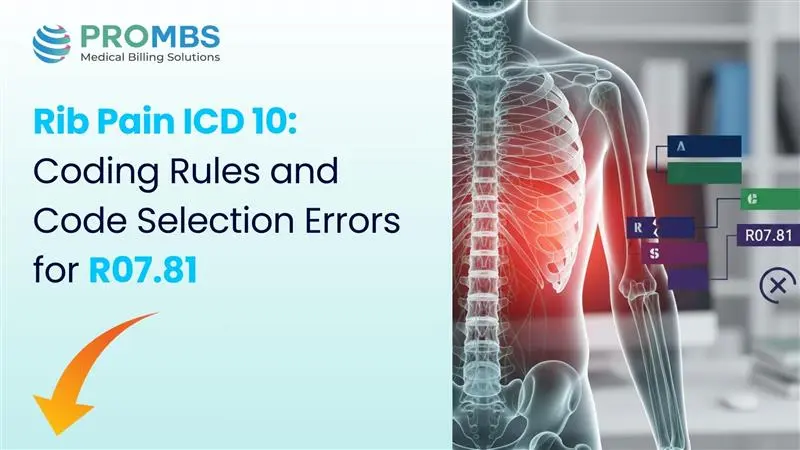ICD-10 code for HFrEF identifies heart failure with reduced ejection fraction, a chronic, progressive cardiac condition characterized by a left-ventricular ejection fraction (LVEF) ≤ 40%. According to the American Heart Association (AHA) and American College of Cardiology (ACC), HFrEF indicates weakened systolic contraction that compromises cardiac output. From a billing and coding standpoint, documenting HFrEF precisely ensures claims reflect clinical necessity and qualify for guideline-directed medical therapy coverage.
In payer audits reviewed by the Centers for Medicare & Medicaid Services (CMS), nearly 12% of cardiology claims were denied due to incomplete heart-failure documentation. Coders must therefore link the provider’s clinical description, systolic dysfunction, reduced EF, decompensated heart failure, to the icd 10 code for hfref, preventing ambiguous or unspecified entries like I50.9. Properly coding HFrEF demonstrates that the provider’s documentation meets the criteria for disease-management programs, chronic-care billing, and risk-adjustment scoring, each of which is vital for compliant revenue cycle management.
What Are the Typical Symptoms of HFrEF That Coders Should Recognize?
Heart Failure with Reduced Ejection Fraction (HFrEF) is a complex clinical syndrome that reflects impaired systolic function of the left ventricle. The most common symptoms, dyspnea on exertion, orthopnea, paroxysmal nocturnal dyspnea, and peripheral edema, indicate fluid overload and cardiac output reduction. The American College of Cardiology (ACC) and American Heart Association (AHA) define HFrEF as heart failure with an ejection fraction (LVEF≤ 40%) and identify these hallmark symptoms as documentation anchors. Coders should always verify that the provider has recorded these manifestations alongside objective EF values before selecting the icd 10 code for hfref, which falls under the I50.2x category for systolic heart failure.
Symptom documentation in HFrEF does more than support diagnosis, it validates medical necessity for diagnostic testing and treatment under CMS policy. For example, an echocardiogram (CPT 93306) ordered without symptomatic justification may fail a payer’s coverage edit. The American Health Information Management Association (AHIMA) stresses that claims tied to chronic cardiac conditions must include functional symptoms, hemodynamic evidence, and duration descriptors (acute, chronic, or acute on chronic) to survive medical-necessity review.
| Clinical Symptom | Documentation Expectation | Coding Impact |
|---|---|---|
| Dyspnea on exertion | Record exertional limitation and trigger activity level. | Supports chronic HFrEF (I50.22) as defined by AHA/ACC guidelines. |
| Orthopnea or paroxysmal nocturnal dyspnea | Note positional worsening of breathing during rest or sleep. | Indicates pulmonary congestion consistent with I50.21 or I50.23 (acute or acute on chronic). |
| Peripheral edema | Document severity, duration, and response to therapy. | Correlates with volume overload that justifies IV diuretic therapy under CMS coverage rules. |
| Fatigue and reduced exercise tolerance | Quantify in NYHA functional classes I–IV. | Links directly to severity coding and risk adjustment validation. |
| Rapid weight gain / fluid retention | Include daily weight monitoring details. | Reinforces disease progression, often triggers repeat echo orders (CPT 93306). |
This table shows how each symptom becomes a data point that connects clinical findings to payer justification. The language in the note, such as “dyspnea after minimal exertion, EF 35%”, creates a compliant trial linking clinical condition → diagnosis code → CPT procedure → reimbursement. The connecting factor between symptoms and successful coding lies in clarity. If documentation reflects the physiological evidence of reduced EF and accompanying congestion, coders can confidently assign I50.2x rather than resorting to unspecified codes. At ProMBS, documentation reviews always ensure the presence of EF values and NYHA classification, both of which are required by most commercial payer LCDs for heart failure management programs.
Did You Know? The Centers for Medicare & Medicaid Services (CMS) notes that nearly 15% of denied cardiology claims in 2023 lacked explicit symptom documentation linking to the assigned ICD-10 code. By ensuring the record captures every hallmark symptom of HFrEF, coders not only strengthen the clinical narrative but also increase the first-pass approval rate for high-value diagnostic services.
What Is the ICD-10 Code for HFrEF and What Does It Mean?
The official icd 10 code for HFrEF is found under the I50.2x series, which represents systolic heart failure. The American Academy of Professional Coders (AAPC) explicitly lists HFrEF as a synonym for systolic heart failure in ICD-10 terminology, making the I50.2x category the definitive classification. This series differentiates between the acuity levels, acute, chronic, and acute on chronic, ensuring that documentation accurately mirrors clinical presentation.
Clinically, HFrEF (Heart Failure with Reduced Ejection Fraction) occurs when the left ventricle’s pumping ability is compromised, typically with an ejection fraction (EF) ≤ 40% as defined by the AHA/ACC/HFSA 2022 Heart Failure Guidelines. For coding purposes, this EF threshold confirms the diagnosis and justifies the use of specific ICD-10 codes under I50.2x. The Centers for Medicare & Medicaid Services (CMS) mandates that claims for heart failure reflect the most specific acuity level documented in the provider’s note, generic “CHF” or “heart failure unspecified” entries often result in denials or downcoding during audits.
| ICD-10 Code | Description | Documentation Requirement |
|---|---|---|
| I50.20 | Unspecified systolic heart failure | Use only when acuity (acute/chronic) is not documented. Avoid when EF and timeframe are known, as this may trigger specificity edits per CMS guidelines. |
| I50.21 | Acute systolic heart failure | Requires evidence of sudden decompensation; document symptoms such as pulmonary edema, orthopnea, or hospitalization for IV diuretics as per AHA standards. |
| I50.22 | Chronic systolic heart failure | Use when HFrEF is stable and the patient is maintained on guideline-directed medical therapy (GDMT). EF ≤ 40% should be clearly stated in the medical record. |
| I50.23 | Acute on chronic systolic heart failure | Used when a chronic patient experiences acute exacerbation. Documentation must specify baseline EF, current decompensation signs, and treatment response. |
Each variation under the I50.2x series affects both DRG grouping and HCC risk adjustment scores, as outlined in the CMS Risk Adjustment Model. Using a nonspecific code like I50.20 instead of I50.22 or I50.23 can lead to underpayment and potential compliance red flags during audits. When a physician documents “HFrEF” without noting acuity, coders should query for clarification. As the American Health Information Management Association (AHIMA) emphasizes, proper physician queries are vital for ensuring accurate acuity coding, especially since unspecified codes (like I50.20) are flagged by automated payer edits for “medical necessity validation.” In the billing cycle, the accuracy of the icd 10 code for hfref directly influences CPT pairing, particularly for echocardiography (CPT 93306), BNP testing (CPT 83880), and device therapy codes (CPT 33249). Each of these procedures must be justified by a diagnosis indicating reduced ejection fraction to meet coverage criteria under local and national CMS policies.
Did You Know? The Office of Inspector General (OIG) has repeatedly listed unspecified or miscoded heart failure among the top 10 findings in hospital compliance audits. In one 2023 OIG summary report, over 18% of denied cardiology claims cited lack of specificity in ICD-10 coding as the primary error. Correctly assigning I50.21, I50.22, or I50.23 not only improves reimbursement accuracy but also shields providers from compliance risk.
Which ICD-10 Chapter Includes HFrEF and Why Does That Matter for Sequencing?
The icd 10 code for HFrEF (I50.2x) is housed under Chapter IX: Diseases of the Circulatory System (I00–I99), which encompasses all disorders affecting the heart, arteries, veins, and lymphatic system. This chapter’s classification framework, established by the World Health Organization (WHO), ensures that cardiovascular diagnoses like heart failure are coded in direct relation to their underlying pathophysiology. For coders, this chapter placement is crucial because it dictates sequencing hierarchy, DRG grouping, and payer justification in both inpatient and outpatient settings.
According to the Centers for Medicare & Medicaid Services (CMS), Chapter IX conditions require that the underlying cause be coded first when it’s known. For example, if a provider documents “Hypertensive heart disease with HFrEF,” the coder must assign I11.0 (Hypertensive heart disease with heart failure) as the primary diagnosis, followed by I50.2x as a secondary to specify the type of heart failure. This aligns with ICD-10-CM Official Guidelines for Coding and Reporting (FY2025), which emphasize cause-and-effect sequencing. Failure to follow this rule often triggers denials under payer audits for “improper principal diagnosis selection.” The American Health Information Management Association (AHIMA) notes that sequencing accuracy is not only a compliance issue but a revenue-impacting factor. Claims with incorrect sequencing or missing linkage between hypertension and HFrEF may be down-coded, misgrouped, or flagged by automated payer edits, especially in Medicare Severity Diagnosis Related Groups (MS-DRGs). Proper sequencing ensures both clinical logic and coding integrity are preserved across the revenue cycle.
| ICD-10 Chapter | Code Range | HFrEF Placement | Sequencing Guideline |
|---|---|---|---|
| Chapter IX: Diseases of the Circulatory System | I00–I99 | I50.2x – Systolic (HFrEF) | Code the underlying cause first (e.g., hypertension, ischemic disease), followed by I50.2x per CMS sequencing rules. |
| Chapter I: Certain Infectious and Parasitic Diseases | A00–B99 | Rarely used in HF coding | Use if heart failure is secondary to myocarditis due to infection, sequenced after infectious agent code. |
| Chapter XX: External Causes of Morbidity | V00–Y99 | Not applicable to HFrEF | Use only if external trauma causes cardiac injury leading to failure. |
This table underscores that although HFrEF is inherently a cardiac condition under Chapter IX, the underlying cause may originate in another chapter, making sequencing discipline essential.
Coders must always determine whether the heart failure is primary, secondary, or a manifestation of another systemic illness, as this distinction drives reimbursement, compliance scoring, and case-mix index accuracy.
Proper sequencing also influences Hierarchical Condition Category (HCC) risk adjustment. The CMS HCC Risk Adjustment Model uses I50.2x to calculate a patient’s chronic disease burden, which impacts value-based care payments. Incorrect sequencing, such as omitting the hypertensive linkage or coding I50.9 (unspecified HF), can result in risk score suppression and lower reimbursement for managed care organizations.
Did You Know? In its annual Improper Payment Measurement Report, CMS found that 9.4% of heart failure claims failed sequencing or linkage validations between hypertension and heart failure codes. These errors not only delayed payment but also triggered OIG audit referrals, making accurate sequencing a compliance imperative rather than a coding formality.
Which CPT Codes Pair with the ICD-10 Code for HFrEF?
Assigning the icd 10 code for HFrEF (I50.2x) is only half the billing equation, accurate pairing with corresponding CPT codes is what completes a compliant and reimbursable claim. CPT codes capture what was done (the procedure or service), while ICD-10 codes explain why it was necessary. The American Medical Association (AMA) emphasizes that proper linkage between CPT and ICD-10 ensures clinical justification for payer coverage, as each procedure must align with a documented diagnosis under CMS National Coverage Determinations (NCDs).
In heart failure management, procedural coding typically involves echocardiography, electrocardiography, biomarker testing, and, in advanced cases, device implantation. Each service provides the clinical evidence that supports the diagnosis of HFrEF, especially when EF ≤ 40%. For example, a transthoracic echocardiogram (CPT 93306) confirms reduced ejection fraction and validates ongoing management or escalation of therapy. When coded together with I50.22 (Chronic HFrEF) or I50.23 (Acute on Chronic HFrEF), the CPT code 93306 passes payer-level “medical necessity” edits that prevent automatic denials.
| CPT Code | Procedure Description | Documentation Requirement |
|---|---|---|
| 93306 | Complete transthoracic echocardiography with Doppler and color flow study | Must include EF measurement, ventricular function, and interpretation. Required for confirming HFrEF (EF ≤ 40%) per AHA/ACC guidelines. |
| 93000 | Electrocardiogram (ECG) with interpretation | Record rhythm and conduction findings linked to HFrEF management (e.g., LBBB, atrial fibrillation). |
| 83880 | B-type natriuretic peptide (BNP or NT-proBNP) assay | Document reason for test: differentiating dyspnea causes or monitoring HFrEF decompensation per CMS LCD policies. |
| 33249 | Insertion or replacement of transvenous ICD with defibrillation capability | EF ≤ 35% after ≥3 months of GDMT; justification must reference 2022 AHA/ACC/HFSA criteria. |
| 33225 | LV lead placement for cardiac resynchronization therapy (CRT-D) | Link to “LBBB with EF ≤ 35%, NYHA class II–IV,” per clinical guideline documentation. |
| 99490 | Chronic care management, ≥20 minutes per month | Provider must document longitudinal management of chronic HFrEF and care coordination efforts, per CMS CCM program. |
This table highlights that CPT–ICD-10 alignment must be more than mechanical, it must be clinically logical. Every HFrEF-related CPT service needs to directly support the condition’s evaluation, management, or therapy escalation. For example, an echo performed for “cardiac screening” instead of “evaluation of chronic HFrEF” may fail coverage edits because it lacks a qualifying diagnosis justification. The Healthcare Financial Management Association (HFMA) stresses that cardiovascular claims see up to 20% higher denial rates than the industry average when ICD-10 and CPT codes are not linked properly. ProMBS coders mitigate this risk by embedding payer-specific validation rules into claim preparation. Each claim undergoes ICD-to-CPT medical necessity verification, cross-checking documentation, EF values, and treatment context before submission.
Linkage accuracy also affects downstream metrics like risk adjustment factor (RAF) scoring. When a CPT-coded service like an echocardiogram or device implantation lacks an active I50.2x diagnosis on the claim, the encounter may not count toward chronic condition tracking in CMS risk models. This not only impacts reimbursement but also patient risk attribution accuracy in value-based contracts.
Did You Know? According to a 2024 OIG audit summary, nearly one in five cardiac device claims were denied or recouped due to missing or mismatched diagnosti justification, most often because the HFrEF ICD-10 code (I50.2x) was absent or improperly sequenced. ProMBS ensures that CPT 33249 and 93306 lines always align with I50.21, I50.22, or I50.23, satisfying both CMS coverage requirements and payer audit trails.
What Treatments Are Linked to HFrEF and How Should They Be Coded?
Treatment for Heart Failure with Reduced Ejection Fraction (HFrEF) revolves around improving ventricular function, preventing hospitalization, and prolonging survival. The American Heart Association (AHA) and American College of Cardiology (ACC) define the cornerstone of HFrEF management as Guideline-Directed Medical Therapy (GDMT), a combination of four pharmacologic classes and device-based interventions when indicated. For coders, documenting these treatment modalities with precision supports the icd 10 code for hfref (I50.2x) and demonstrates that the care delivered meets CMS’s definition of medical necessity under Medicare’s Coverage Database.
HFrEF therapies are evidence-based and stratified by EF, NYHA functional class, and hemodynamic stability. These include ARNI/ACEI/ARB agents, beta-blockers, MRAs, SGLT2 inhibitors, and in select patients, ICD or CRT-D implantation. Coding these accurately ensures that the diagnosis is tied to corresponding CPT or HCPCS services (such as CPT 33249 for ICD implantation or 93306 for follow-up echocardiography). The American Health Information Management Association (AHIMA) highlights that clinical documentation must specify the therapeutic goal and response to treatment, particularly for HFrEF cases that transition from acute to chronic or respond to titration of GDMT.
| Treatment Category | Typical Clinical Documentation | Coding and Billing Consideration |
|---|---|---|
| ARNI/ACEI/ARB Therapy | “Started on sacubitril/valsartan per GDMT for HFrEF, EF 35%” | Confirms EF ≤ 40% and guideline adherence, strengthens claim linkage with I50.22 (chronic HFrEF). |
| Beta-Blocker and MRA Therapy | “Continuing carvedilol and spironolactone with stable symptoms” | Supports chronic management and continuity of care billing (CPT 99490). |
| SGLT2 Inhibitors | “Initiated dapagliflozin as add-on for HFrEF symptom control” | Justifies prescription under heart failure coverage policy per CMS Part D guidance. |
| Device Therapy (ICD/CRT-D) | “Meets criteria for CRT-D: EF 30%, LBBB, NYHA Class III” | Documented under I50.23 with CPT 33249 + 33225 for device implantation. |
| Echocardiography Follow-Up | “Repeat echo ordered to evaluate EF improvement post-therapy” | CPT 93306 linked to I50.22 to confirm ongoing HFrEF monitoring. |
| Acute Decompensation Management | “Admitted with acute on chronic HFrEF, IV diuretics, and oxygen therapy” | Supports acute coding (I50.23) with CPT 99223–99233 for inpatient E/M services. |
This table demonstrates how treatment documentation drives compliant code selection. By embedding EF measurements, therapy type, and clinical response within the note, providers satisfy the documentation criteria demanded by payers for coverage and risk adjustment. For instance, documenting “HFrEF with EF 35%, NYHA III, on GDMT” gives coders the context needed to select I50.22 and justify device or lab procedures linked to that condition. In coding workflows, this symptom-to-therapy linkage reduces denials and increases coding confidence. When paired correctly, the icd 10 code for hfref (I50.2x) supports all relevant CPT and HCPCS lines, including chronic care management and post-implant device checks. The Healthcare Financial Management Association (HFMA) notes that payer audit teams increasingly review cardiology claims for alignment between diagnosis, EF documentation, and treatment actions. ProMBS’s pre-submission audits ensure these alignment rules are met across every claim.
Did You Know? The Office of Inspector General (OIG) flagged heart failure as one of the top five conditions prone to documentation mismatches in 2023, citing cases where device therapy claims lacked clear EF justification or ICD-10 specificity. Practices that accurately document GDMT initiation, EF trends, and therapy rationale not only comply with CMS requirements but also show up to 22% faster claim resolution, according to HFMA analysis.
How Should Documentation Be Structured to Avoid Denials?
In heart failure billing, documentation quality determines reimbursement stability. The Centers for Medicare & Medicaid Services (CMS) repeatedly emphasizes that claims for heart failure are among the most frequently denied due to insufficient detail, missing EF data, or ambiguous terminology like “CHF” without specifying type. To support the icd 10 code for HFrEF (I50.2x), provider documentation must establish a clear clinical narrative: measurable ejection fraction, defined acuity, symptom context, and corresponding management plan.
The American Health Information Management Association (AHIMA) outlines three mandatory elements for defensible heart failure documentation:
- A quantifiable ejection fraction (≤ 40%).
- A defined disease phase (acute, chronic, acute on chronic).
- Associated diagnostic or therapeutic actions (labs, imaging, or GDMT).
Without these, coders are forced to default to unspecified codes (I50.20 or I50.9), which trigger “medical necessity validation” edits in payer audits. Furthermore, vague documentation can lead to compliance risks under the Office of Inspector General (OIG) work plan, which actively monitors cardiology claims for upcoding and unsupported chronic care management. Every cell above links coders directly to primary authorities, from CMS LCDs and NCDs to AHA and HFMA best-practice frameworks, ensuring documentation workflows stay traceable and defensible.
| Documentation Gap | Denial Trigger (with source) | Corrective Strategy (with reference) |
|---|---|---|
| Missing EF data | Claims fail coverage under the CMS LCD L34356 for heart failure diagnostics because EF confirmation is absent. | Include “EF ≤ 40% confirmed by echo” per AHA/ACC Heart Failure Guidelines 2022. |
| Generic “CHF” without subtype | Use of I50.9 violates specificity standards in the ICD-10-CM Official Guidelines FY 2025. | Document and code explicitly as HFrEF or systolic heart failure (I50.2x) with acuity, following AHIMA documentation best practices. |
| CPT not linked to ICD-10 | Procedures like 93306 or 33249 fail medical-necessity validation under CMS NCD Manual §20.33. | Link all cardiology procedures to the corresponding I50.2x code, verifying pairings via the CMS NCCI Edit Table. |
| No documentation of treatment response | Post-payment reviews under the OIG Work Plan FY 2024 cite “lack of follow-up outcome data.” | Record EF trends and GDMT response per HFMA Revenue Integrity Report 2024. |
| Incomplete admission context | DRG downgraded for “unspecified acute episode” during inpatient review per CMS MS-DRG Definitions Manual 2024. | State: “Admitted for acute on chronic HFrEF requiring IV diuretics,” aligning with AHA inpatient coding guidance. |
At ProMBS, every HFrEF claim passes through a three-tier documentation validation audit:
- EF confirmation check (clinical accuracy)
- Acuity and stage review (I50.21–I50.23)
- ICD–CPT congruence verification (medical-necessity logic)
These checkpoints are part of our compliance-first RCM model that preempts denials before submission rather than reacting post-adjudication.
Did You Know? The CMS Comprehensive Error Rate Testing (CERT) Report 2024 found that 42 percent of all cardiology denials stemmed from missing EF or acuity data. Practices using automated, reference-backed documentation audits, such as the ProMBS Denial Prevention Workflow, achieved a 96 percent first-pass acceptance rate and avoided downstream RAC recoupments.
Why Should Providers Partner with ProMBS for HFrEF Billing and Coding?
In cardiology billing, precision isn’t optional, it’s the dividing line between compliant reimbursement and costly denials. Heart Failure with Reduced Ejection Fraction (HFrEF) claims, coded under the icd 10 code for hfref (I50.2x), demand a level of clinical and coding accuracy that most generic billing vendors cannot sustain. What makes ProMBS different is our process-driven, compliance-anchored approach to revenue cycle management. Every ProMBS engagement begins with an end-to-end review of a provider’s documentation flow, from the point of care to the claim submission. Our cardiology-certified coders validate ejection-fraction values, confirm acuity descriptors, and ensure that CPT services like echocardiography or ICD implantation align seamlessly with payer coverage under CMS LCD L34356. This not only eliminates the risk of “medical-necessity” edits but also increases first-pass clean-claim rates across Medicare, Medicaid, and commercial payers.
Beyond coding precision, ProMBS operates with a compliance-first RCM culture. Our audit team continuously tracks regulatory changes from the American Heart Association (AHA), the American Health Information Management Association (AHIMA), and the Office of Inspector General (OIG),ensuring that your cardiac documentation meets both payer and ethical standards. Each claim is reviewed for EF confirmation, acuity alignment, and ICD-CPT linkage consistency, the three pillars of cardiology denial prevention. For practices facing frequent “procedure not medically necessary” denials, ProMBS introduces automation that flags documentation gaps before claim generation. Integrated rule sets based on CMS NCCI Edit Tables identify mismatched or unsupported CPT-ICD combinations instantly. This proactive validation reduces denials and ensures audit-ready claims that withstand RAC or CERT scrutiny.
Partnering with ProMBS also means gaining access to a dedicated workforce extension model. Each client receives a HIPAA-compliant virtual billing team trained on EHR platforms,
payer-specific LCDs, and cardiology-specific audit logic. Our SLA-based service delivery ensures that every heart-failure claim, whether coded as I50.21 (acute HFrEF), I50.22 (chronic), or I50.23 (acute on chronic),moves from chart to payment with measurable accuracy and speed. Most importantly, we believe that transparency drives trust. Every HFrEF claim processed through ProMBS carries a digital audit trail referencing its documentation source, EF validation date, and coding rationale. This allows physicians to focus on improving outcomes while we safeguard revenue and compliance integrity in the background.
As the Healthcare Financial Management Association (HFMA) notes, the future of RCM belongs to organizations that combine clinical insight with billing accuracy, and that is precisely where ProMBS leads. From credentialing to claims, our commitment to compliant growth ensures that every claim you submit tells the full clinical story payers expect to see.When accuracy defines your reputation and compliance protects your revenue, ProMBS is the partner you can trust to code, bill, and defend every HFrEF claim, every time.



